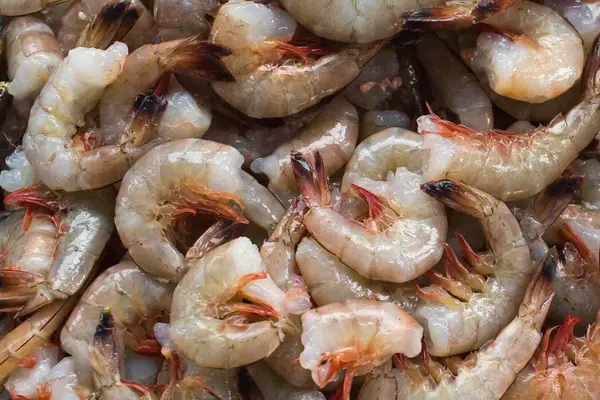Shrimp is a popular seafood choice for many people, but it can go bad quickly if not stored properly.
Whether you’re cooking with fresh shrimp or using frozen, it’s important to know how to tell if shrimp is bad to avoid food poisoning or other health risks.
In this blog post, we’ll go over some simple tips and tricks for determining if shrimp has gone bad and what to do if you suspect that your shrimp has spoiled.
By following these guidelines, you can feel confident in the safety and quality of the shrimp you’re consuming.
7 Signs Of Spoiled Shrimp
1. Strange Odor
If the shrimp has a strong, fishy smell or an unpleasant, sour odor, it’s likely spoiled. Fresh shrimp should have a slightly sweet and salty smell.
2. Slimy Texture
Shrimp that is starting to spoil will often have a slimy or sticky texture, even after being rinsed.
3. Discoloration
Fresh shrimp should be pink or gray in color, depending on the species. If the shrimp has turned yellow, brown, or black, it’s a sign that it’s spoiled.
4. Soft Or Mushy Consistency
Fresh shrimp should be firm and have a slight bounce when touched. If the shrimp is soft or mushy, it’s likely spoiled.
5. Presence Of Mold
If you see any mold growing on the shrimp, it’s definitely spoiled and should be thrown away.
6. Off Taste Or Smell
If the shrimp tastes or smells off, even after cooking, it’s likely spoiled.
7. Expired Sell-By Date
Always check the sell-by date on the packaging before purchasing or consuming shrimp. If the shrimp is past the sell-by date, it’s likely spoiled.
If you notice any of these signs, it’s best to discard the shrimp and purchase a fresh batch. It’s better to be safe than sorry when it comes to food safety.

How Long Is Shrimp Good For In The Fridge?
The shelf life of shrimp depends on how it was stored before being placed in the fridge. If the shrimp was purchased fresh and kept on ice at the grocery store or fish market, it should be eaten within a day or two of purchase. If the shrimp was previously frozen, it should be eaten within three to five days of thawing.
If you need to store cooked shrimp in the fridge, it should be eaten within three to four days. Shrimp can be stored in an airtight container in the refrigerator for this amount of time. It’s important to keep the shrimp chilled at all times to prevent bacterial growth.
To extend the shelf life of shrimp, it can be frozen. Frozen shrimp can be stored in the freezer for up to six months, but it’s best to use it within the first three months for the best taste and texture.
When thawing frozen shrimp, it’s important to do so in the refrigerator or under cold running water to prevent bacterial growth. Do not leave frozen shrimp at room temperature to thaw.
It’s always best to use shrimp as soon as possible for the freshest taste and highest quality. Be sure to check the sell-by date and follow proper storage guidelines to ensure that your shrimp is safe to eat.
Can Shrimp Go Bad In The Freezer?
Shrimp can go bad in the freezer if it is not stored properly. Freezing can slow down the spoilage process and extend the shelf life of shrimp, but it does not stop the spoilage process completely.
If the shrimp has been previously frozen and then thawed, it should be eaten within three to five days. If the shrimp was never frozen but has been stored in the freezer for an extended period of time, it may have developed freezer burn or become dry and tasteless.
Does Bad Shrimp Taste Different?
Bad shrimp will often have a strong, fishy smell or an unpleasant, sour odor. It may also have a slimy or sticky texture and may appear discolored or have visible signs of spoilage, such as mold.
In addition to these physical signs, bad shrimp may also have an off taste or smell, even after cooking.
What Happens If You Eat Bad Shrimp?
Eating bad shrimp can cause food poisoning, which is an illness caused by consuming contaminated food or drinks.
Symptoms of food poisoning can vary depending on the type of contamination, but common symptoms include nausea, vomiting, diarrhea, abdominal cramps, fever, and chills. In severe cases, food poisoning can lead to dehydration, organ failure, and even death.
If you suspect you have consumed bad shrimp, it’s important to seek medical attention immediately, especially if you are experiencing severe symptoms.
It’s also a good idea to discard any remaining shrimp and thoroughly clean any surfaces or utensils that came into contact with the contaminated shrimp.
How To Store Shrimp?
There are a few key steps to follow when storing shrimp to ensure that it stays fresh and safe to eat:
1. Keep It Chilled
Shrimp should be stored in the refrigerator at a temperature of 40°F (4°C) or below to prevent bacterial growth. If you’ve purchased fresh shrimp, keep it on ice until you’re ready to use it.
2. Store It Properly
Shrimp should be stored in an airtight container or wrapped tightly in plastic wrap or aluminum foil. This will help to protect it from air exposure, which can cause spoilage.
3. Label It
If you plan on storing shrimp in the freezer, be sure to label it with the date it was frozen. This will help You Keep Track Of The Shelf Life Of The Shrimp And Ensure That It Is Used Within A Reasonable Timeframe.
4. Follow Proper Thawing Techniques
When thawing frozen shrimp, it’s important to do so in the refrigerator or under cold running water to prevent bacterial growth. Do not leave frozen shrimp at room temperature to thaw.
Following these guidelines can help ensure that your shrimp stays fresh and safe to eat. It’s always best to use shrimp as soon as possible for the freshest taste and highest quality.
Conclusion
In conclusion, it’s important to know how to tell if shrimp is bad to avoid food poisoning or other health risks. By following some simple tips and tricks, such as checking for strange odors, slimy textures, discoloration, and the presence of mold, you can easily determine if your shrimp has gone bad.
It’s also important to check the sell-by date and follow proper storage guidelines to ensure that your shrimp stays fresh and safe to eat.
If you suspect that your shrimp is bad, it’s best to discard it and purchase a fresh batch. You can enjoy shrimp with confidence and peace of mind by being proactive and taking the necessary precautions.
- Jet’s Ranch Recipe: Make The Famous Dip At Home - April 12, 2025
- James Hemings Macaroni And Cheese Recipe – History On A Plate - April 3, 2025
- French Dip Squares Recipe – Better Than A Sandwich! - March 25, 2025


